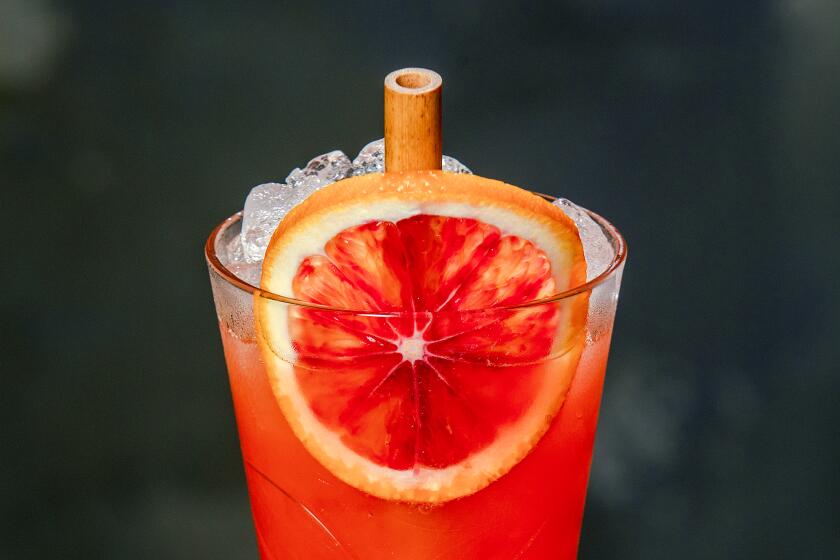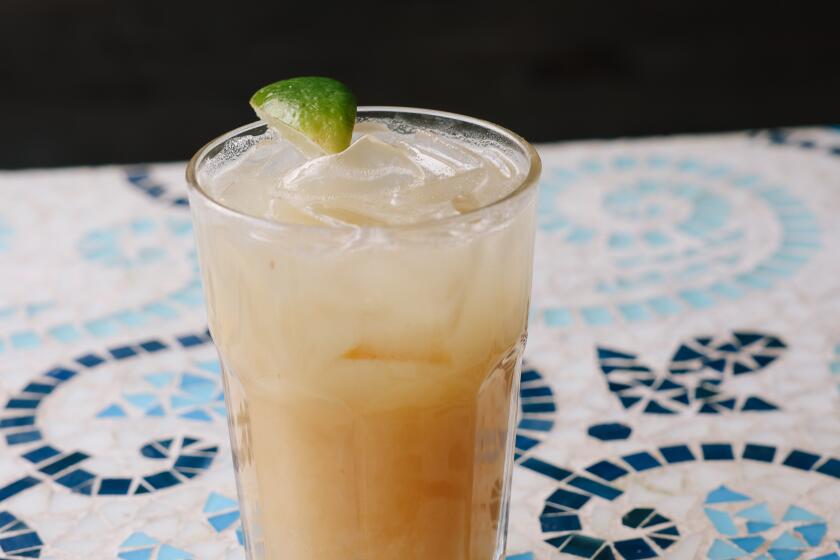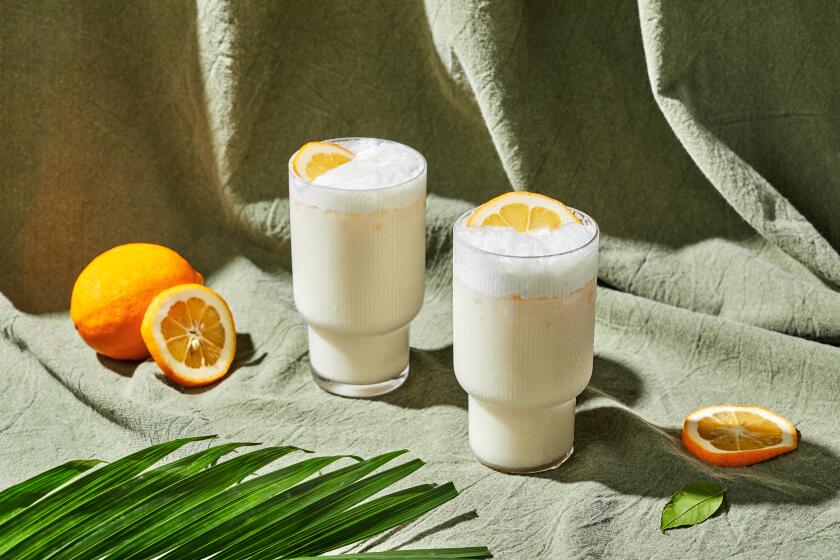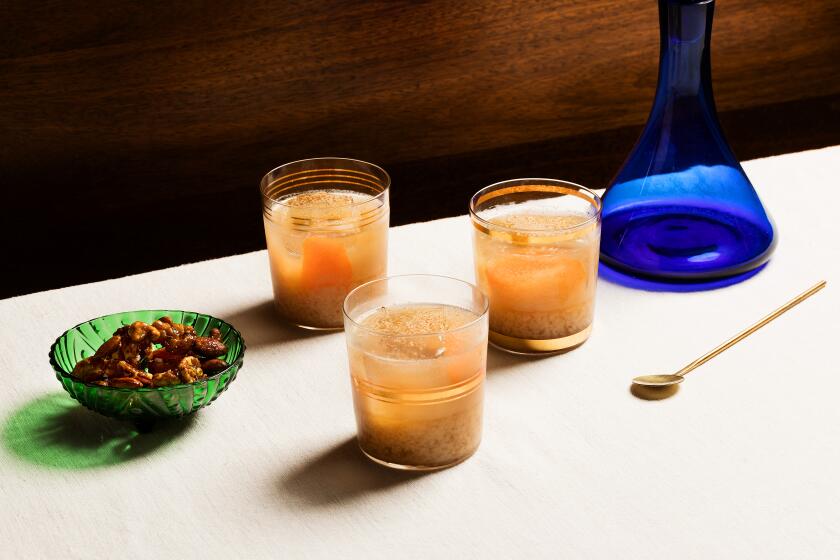Mother's Ruin
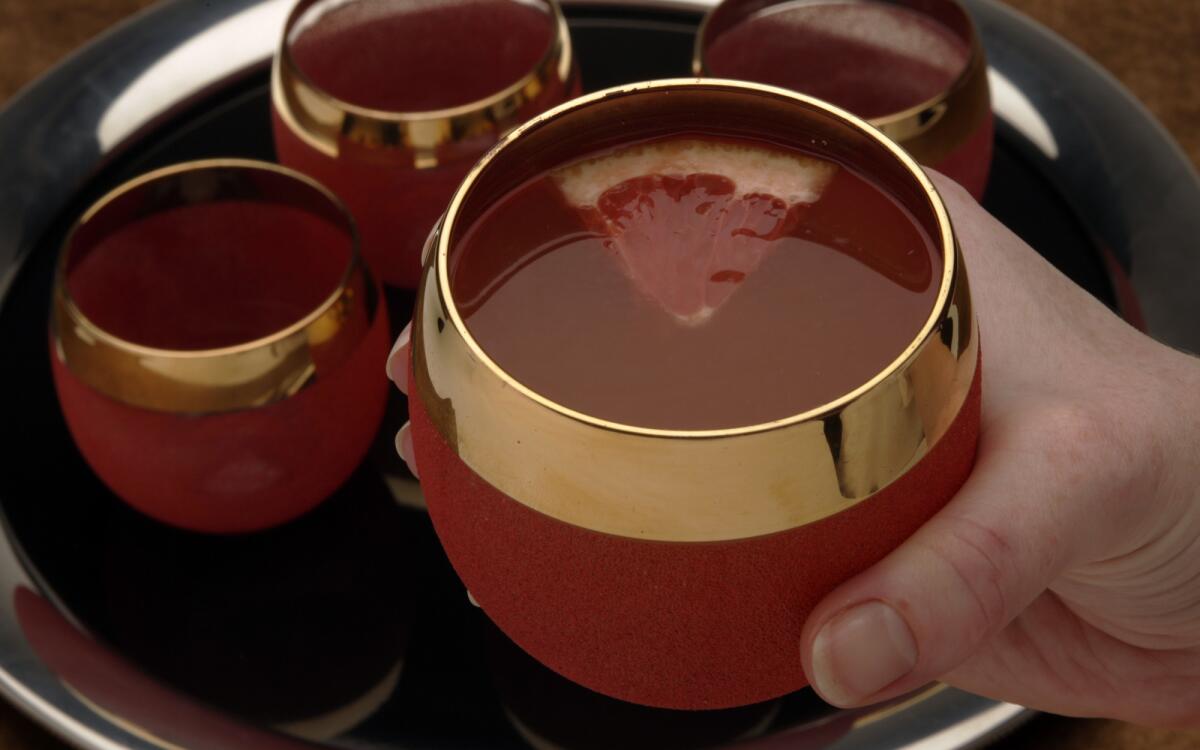
At the Edison downtown, bartender Marcos Tello -- dressed in one of his natty striped-flannel vest-and-pants numbers from La Rosa Vintage in San Francisco and gray patent leather John Fluevog wing tips -- is peeling a dozen lemons with a trusty potato peeler (he peels them in careful spirals, so that each peel remains in one long strip -- the easier to fish them out with a bar spoon later). He places the peels in sugar and, biceps bulging, begins to muddle, and muddle, and muddle.
A classic punch starts with this mixture of lemon peels muddled with sugar, which he refers to as “oleo saccharum” (sweet oil). “You want the oils from the lemon peel to impregnate the sugar,” Tello says. After several minutes, the sugar becomes moist and is tinged yellow from the oils. This is going to be good punch.
Punch -- big bowls of it -- is the latest trend among “cocktailians” who prefer their ice hand-chipped or cringe when their Negronis are shaken.
They’re already popular in New York. At Clover Club, which opened in Brooklyn this summer, among owner Julie Reiner’s fizzes and sours and daisies, juleps and smashes and swizzles, seasonal punches entice patrons who have settled in for the night in front of the fireplace or have stopped in on their way to Lucali for pizza.
Death + Co. in Manhattan puts up to a half-dozen at a time on its menu, listed under “A Lovely Bowl of Punch.” For example, Mother’s Ruin: Plymouth gin, tea-infused sweet vermouth, lemon and grapefruit juices, topped with Champagne and garnished with slices of grapefruit, served to the table in a vintage milk-glass punch bowl.
“If we send one punch bowl out” to a table, says Death + Co. co-owner David Kaplan, “we know we’ll have two or three or four or five more go out.”
Bartender Eric Alperin has punch visions for his venture with New York-based Milk & Honey proprietor Sasha Petraske -- Varnish, the forthcoming speak-easy at Cole’s in downtown L.A., which is set to open in the new year. “I want to offer it so that when people come in, right away before they even get a cocktail, they can have a little punch, like an amuse,” Alperin says. “I would like to keep it in view, right on top of the bar, as if you were saying -- well, people see a bowl of punch and they go, ‘Wait a second, there’s a party happening.’ ”
At the Edison, Tello has been mixing them for special occasions, such as New Year’s Eve.
--
Old is new again
It seems natural that the revival of classic cocktails that has returned pre-Prohibition drinks and a drinking culture to stardom would shore up punch, which predates the cocktail but fell out of favor in the 19th century. “For nearly 200 years, from the 1670s to the 1850s, the Kingdom of Mixed Drinks was ruled by the Bowl of Punch,” writes cocktail historian David Wondrich in his book “Imbibe!” The title of his next book says it all, or a lot, anyway: “Punches, or the Delights and Dangers of the Flowing Bowl” (to be published in 2010).
Its delights are apparent, and maybe its dangers are too -- punch can be potent stuff. “The famous punch parties of the 18th century were knock-down, drag-out affairs,” Wondrich says, when men with “extraordinarily bad habits” made fantastic punches.
Tello of the Edison is making a ginormous bowl of punch that he calls Whiskey Barrel punch, which contains not one but two bottles (and not just 750 milliliters but 1 liter each) of bourbon as well as a bottle of Champagne. It serves 20 to 30, he says. “This may seem like a lot of punch, but believe you me, it goes really fast.” What’s not to believe?
The timing couldn’t be better for a classic-punch comeback. It’s a cold, cold world out there, so gather ‘round the punch bowl, no better place to commiserate and/or celebrate.
“Because people serve themselves and glasses are small, people have to keep clustering around the bowl,” says Wondrich, who makes punch for his own parties. “The focus is on interaction and socialization.”
“It’s communal, it’s a good group thing,” Clover Club’s Reiner says, “and everyone’s enjoying the same thing at the same time. That was the idea behind it. It was my answer to bottle service, which I hate.”
Back at the Edison, Tello stirs the lemon juice into the sugar and discards the peels. “Sugar dissolves best in warm water, in citrus juice less so, but in alcohol it’s even tougher to get the sugar dissolved. So I don’t add the alcohol yet. Don’t add everything at once.”
He next pours in pomegranate syrup (“the original grenadine”) and shakes 15 dashes of Angostura bitters into the mixture. “That’s your spice,” he says.
According to accepted wisdom, the original punch -- quaffed by British sailors in India -- contained five ingredients (one theory is that the word derives from panch, or “five” in Hindustani): spice, citrus, sugar, water, spirits. A broader way of looking at it is: bitter, sour, sweet, weak and alcoholic.
--
An open mind
“There’s a proper way to approach things, but I don’t think there’s any one way to do everything,” Tello says as he pours in the two bottles of Woodford Reserve “Edison edition” bourbon (blended specially for the Edison).
“At this point you should taste and see if it needs adjustment,” he says, taking a sip from his bar spoon. “I like it on the tart side, but I might go with a little more pomegranate syrup.”
Now it’s time to prep the punch bowl, particularly the big block of ice, so that the concoction stays cold but doesn’t get overly diluted as your party progresses. Tello saves 64-ounce juice cartons (such as from orange juice), washes them out, fills them with water and puts them in the freezer to have on hand for punches.
Tello puts the finishing touch on his punch, topping off the bourbon-based mixture with Champagne. “This is great for the holidays. You make this, you can enjoy the party too -- you’re not stuck all night making cocktails. And people see a big bowl of cocktail and they can’t help but want some.”
Tea-infused sweet vermouth
Pour the vermouth into a pitcher. Add the tea and set aside for 1 1/2 hours, stirring occasionally.
Strain the infused vermouth using a fine-mesh strainer lined with cheesecloth and pour the vermouth back into the bottle. Refrigerate until ready to use. The vermouth will keep, refrigerated, for one month.
Assembly
In a sturdy medium bowl, muddle together the sugar cubes, lemon and grapefruit juices until the sugar is dissolved. Add ice to chill, as well as the vermouth and gin, stirring well to combine. Stir in the soda and Champagne until well-combined, then strain into a chilled punch bowl.
Garnish with grapefruit slices and serve immediately.
Get our Cooking newsletter.
Your roundup of inspiring recipes and kitchen tricks.
You may occasionally receive promotional content from the Los Angeles Times.












